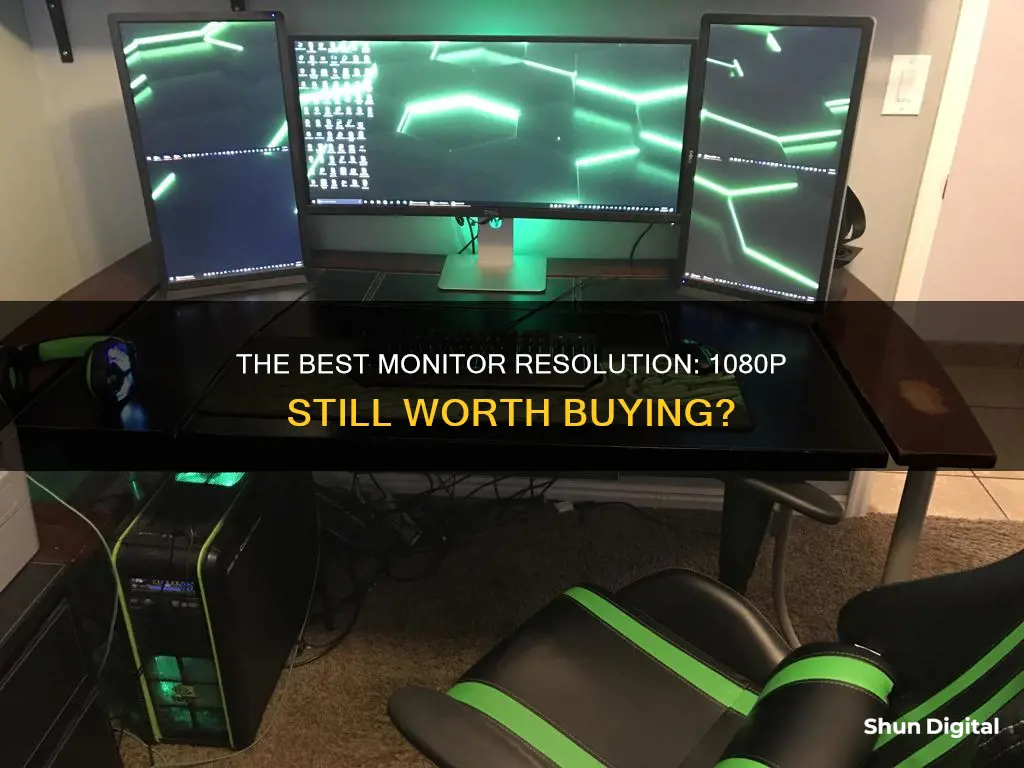
The debate surrounding 1080p monitors continues to rage on, with some arguing that it is no longer suitable for high-mid tier PCs in 2023. However, others claim that 1080p is still good enough for most people, especially those prioritising high frame rates over high resolutions. With the majority of Steam users still playing at 1080p, it is clear that this resolution has stood the test of time.
So, is it still worth buying a 1080p monitor? The answer may depend on your intended use. For competitive gamers, a 1080p monitor with a high refresh rate could be a worthwhile investment, offering sharp motion and a responsive feel. Additionally, 1080p monitors tend to be cheaper and more widely available than higher-resolution options. However, if you're looking for a monitor for productivity tasks or graphically-intensive work, you may want to consider a higher-resolution display, such as 1440p or 4K, which offer enhanced picture quality and clarity.
| Characteristics | Values |
|---|---|
| Industry standard | 1080p is the industry standard for most display devices, including monitors, smartphones, and televisions. |
| Cost | 1080p monitors are less expensive than 1440p monitors. |
| Energy consumption | 1080p uses less energy and computing power than 1440p. |
| Image quality | 1440p offers a more vivid and sharp image quality than 1080p. |
| Ideal for gaming | 1440p is ideal for gaming due to its higher image quality and ability to notice small elements. |
| Ideal for working | 1440p is preferred for working, especially for professionals in video editing and other tech fields, as it provides a larger workspace. |
| Future-proof | 1440p is considered more future-proof than 1080p. |
What You'll Learn

1080p monitors are more affordable than 1440p monitors
The affordability of 1080p monitors is particularly noticeable when comparing prices with 1440p monitors of similar sizes. For example, you can find 27-inch 1080p monitors that are much cheaper than 27-inch 1440p monitors. This price difference makes 1080p monitors a more accessible option, especially for those on a tight budget or looking for a good value purchase.
In addition to the upfront cost, 1080p monitors also tend to have lower running costs compared to 1440p monitors. This is because 1080p monitors use less energy and computing power to run. They require less CPU power for decoding and consume less bandwidth, resulting in lower power consumption and potentially lower utility bills over time.
The affordability of 1080p monitors also extends to the hardware required to support them. Since 1080p resolution is widely used, there is a large selection of compatible hardware available at various price points. This includes both low-end and high-end computers, graphics cards, and other peripherals, making it easier to find affordable options that meet your needs.
While 1440p monitors offer higher resolution and improved visual quality, they come at a higher cost. The advanced technology and enhanced visuals of 1440p monitors result in a higher price tag, both for the initial purchase and the ongoing running costs. Therefore, if you are looking for a cost-effective option, 1080p monitors are a more affordable choice compared to 1440p monitors.
Monitoring App Resource Usage: A Comprehensive Guide
You may want to see also

1080p is the industry standard for most display devices
1080p, or Full HD, has become the industry standard for most display devices, including monitors, smartphones, and televisions. Its dimension of 1920x1080 pixels offers a far better resolution and viewing experience compared to its predecessors.
Today, most programs are optimized for at least 1080p screen resolution, and it is the most popular configuration used today. You will be satisfied most of the time with its performance, and it also has other benefits. It will use less energy and computing power, and it is more affordable, even at larger display sizes.
If you are a gamer, 1080p is still a good option. For fast-paced shooters like Valorant and Counter-Strike: Global Offensive, 1440p doesn't really matter. You are too attentive to the mental game and your aim to care about the graphics. 1080p is also a good option if you are on a budget, as 1440p monitors are more expensive and require better hardware to run.
However, if you are a fan of open-world games with beautiful sceneries, a 1440p monitor will enhance your experience. You will be able to notice even the smallest details, and you can zoom out without compromising image sharpness. If you have the budget and the hardware to support it, 1440p is worth considering for a more immersive experience.
Monitoring Report Usage: Strategies for Effective Data Tracking
You may want to see also

1440p monitors are ideal for gaming and graphics-intensive tasks
The higher resolution of 1440p monitors also means that they can display finer details and sharper images than 1080p monitors. This is especially beneficial for graphics-intensive tasks such as photo or video editing, computer-aided design, and 3D rendering. The increased screen real estate also improves productivity by allowing you to have multiple windows open side by side.
Additionally, 1440p monitors are available in a wide range of refresh rates, from 144Hz to 360Hz, ensuring smooth gameplay and reducing screen tearing. The higher refresh rates also reduce eye strain and provide a more fluid viewing experience.
When choosing a 1440p monitor, it's important to consider its response time for sharp motion handling and the VRR format it supports to ensure compatibility with your graphics card. Most 1440p monitors are available in 27-inch or 32-inch sizes, so you can choose the one that best suits your needs and preferences.
In terms of specific recommendations, the Gigabyte AORUS FO27Q3 is an excellent option for gamers who want graphically intense games at high frame rates. It has a QD-OLED panel, a 360Hz refresh rate, and a near-instantaneous response time. The Dell Alienware AW2725DF offers similar performance and is another great choice.
If you're looking for a more affordable option, the ASUS ROG Strix OLED XG27AQDMG is a good choice. It has a lower 240Hz refresh rate but still offers a near-instantaneous response time. For an even more affordable option, the LG 27GR83Q-B is a great mid-range pick, offering a 27-inch screen, a 240Hz refresh rate, and excellent motion handling.
Overall, 1440p monitors provide a great balance between image quality and gaming performance, making them ideal for gamers and those who need high-resolution displays for graphics-intensive tasks.
Transforming CNC CRT Monitors to LCD Displays
You may want to see also

1080p monitors are sufficient for most digital work
While 1440p monitors offer a more vivid and sharp image, as well as a larger workspace, 1080p is still the most common resolution and will provide a high-quality image for most users. For gamers, 1080p is also a good option, as it allows for higher frame rates, which is often more important than resolution.
Additionally, 1080p monitors are a good choice for those who want to save money, as they are much more affordable than 1440p or 4K monitors, even at larger display sizes. For example, a 27-inch 1080p monitor will be significantly cheaper than a 27-inch 1440p monitor.
However, it is worth noting that some people may prefer the higher resolution of 1440p, especially for gaming or certain types of digital work such as video editing. If you are looking for the most immersive viewing experience or need a larger workspace, then 1440p may be a better option, but it will also be more expensive and may not be compatible with older PCs.
In conclusion, 1080p monitors are sufficient for most digital work and offer a high-quality image at an affordable price. While 1440p monitors provide a higher resolution and some additional benefits, 1080p is still the industry standard and will meet the needs of most users.
Troubleshooting Monitor: Backlight or Broken?
You may want to see also

1440p monitors are more visually appealing and offer a larger workspace
1440p monitors offer a significant upgrade in visual appeal and workspace size compared to 1080p monitors.
For starters, 1440p monitors provide a much sharper and clearer image. With a higher resolution, you'll notice improved picture quality, making games and multimedia content look more detailed and immersive. This enhanced visual experience is particularly noticeable when viewing photos, watching videos, or playing games with high-quality graphics. The increased pixel density of a 1440p monitor, especially at a 27-inch size, strikes a perfect balance between clarity and comfort, ensuring that text, icons, and graphics are crisp without being obnoxiously small.
Additionally, 1440p monitors offer a larger workspace, providing you with more screen real estate for multitasking. This extra space can be incredibly useful if you often work with multiple windows or applications open simultaneously. You'll be able to fit more information on your screen, reducing the need for constant alt-tabbing or window management. This added workspace can significantly improve your productivity, especially for tasks that require referencing multiple sources or working with large datasets.
The benefits of 1440p monitors extend beyond just visuals and workspace. These monitors are designed to strike a balance between image quality and gaming performance. The 1440p resolution is less demanding on your graphics card compared to higher resolutions, allowing you to achieve higher frame rates, which is ideal for gaming. 1440p monitors also come in a wide range of refresh rates, catering to all types of gamers. Whether you're a casual or competitive gamer, you'll find 1440p monitors that offer smooth and responsive performance, with some models reaching refresh rates of up to 360Hz.
Furthermore, 1440p monitors are widely compatible with current-generation gaming consoles, such as the PS5 and Xbox Series X|S, which support 1440p signals. This compatibility ensures that you can take full advantage of the improved visuals and performance offered by these consoles.
When choosing a 1440p monitor, consider factors such as response time for sharp motion handling and VRR format support to ensure compatibility with your graphics card. Most 1440p monitors are available in 27-inch or 32-inch sizes, so you can select the option that best suits your preferences and setup.
While 1080p monitors may still be serviceable, upgrading to a 1440p monitor will provide you with a more appealing visual experience, increased workspace, and improved performance for gaming and multitasking. The enhanced resolution, workspace, and compatibility of 1440p monitors make them a compelling choice for anyone seeking an upgraded viewing experience without compromising on performance.
Identifying Acer Monitors: A Comprehensive Guide to Model Identification
You may want to see also
Frequently asked questions
1080p is the most popular configuration used today and is the industry standard for most display devices, including monitors, smartphones, and televisions. It offers a far better resolution and viewing experience than its predecessors. However, 1440p is considered better for gaming and other graphics-intensive tasks due to its higher resolution and immersive experience.
1080p monitors are less expensive, use less energy and computing power, and are currently the standard screen resolution. 1440p monitors, on the other hand, offer a more vivid and sharp image, making them ideal for gaming and graphics-intensive work.
The main factors to consider are budget and computer performance. 1080p monitors are more affordable, while 1440p monitors offer a more immersive experience. Additionally, your computer's performance capacity should be considered, as a lower-end PC may struggle with the higher output of a 1440p monitor.







